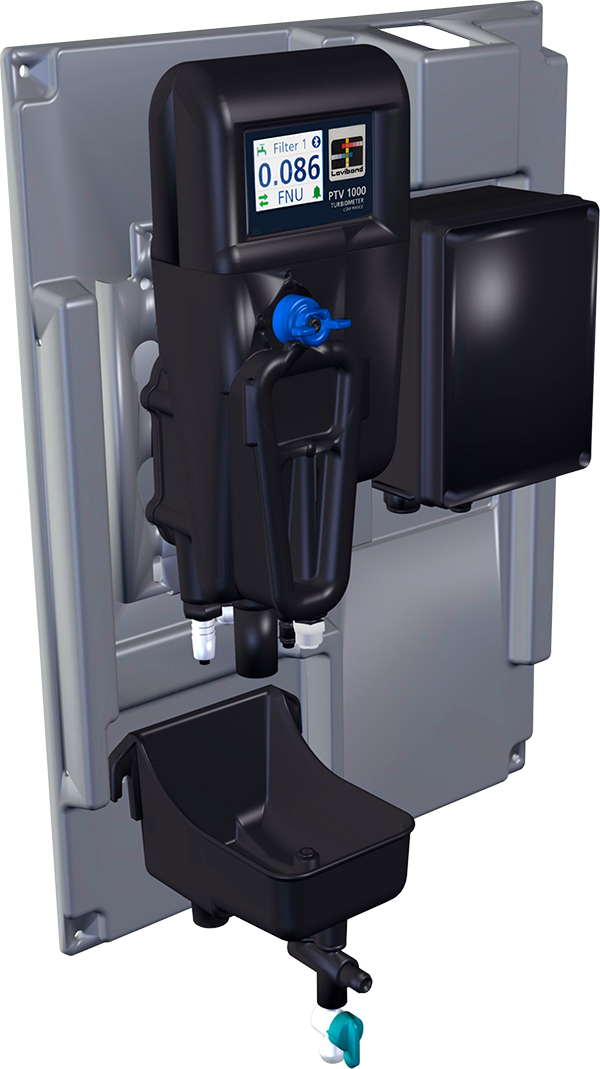Turbidity has long been one of the key indicators in determining water quality. However, it is well recognised within the industry that because of the effect of instrument design on readings, different instruments can give different results on the same sample. There are a number of reasons for this, some to do with the instruments incident light and scattered light detection angle, and some to do with how the sample is presented to the instrument.
Turbidity can be a complex measurement to do, especially at the very low levels required in UK drinking water production. Measurement can be affected by the size and shape of the material scattering the light, the sample colour and then the distribution of the material in the sample.
To overcome these issues, a new turbidity instrument has been developed, created by an expert team led by world-renowned turbidity expert Mike Sadar. The online instrument they designed sought to address the common issues with the presentation of the sample to the instrument.
The challenges of turbidity measurement:

A new way of measuring turbidity has been developed, the PTV 1000 from Lovibond, which incorporates the expertise of a team with over 100 years of experience in turbidity measurement.
Bubbles
Bubbles are the bane of turbidity measurement and a number of methods of removing them from the sample prior to measurement have been attempted by manufacturers over the years. To eliminate bubbles from entering the measurement chamber, the new instrument design incorporates an integral patented bubble trap mechanism, using both horizontal and vertical flow to trap and remove even microbubbles from the instrument prior to measurement.

Sample cell
Any surface that comes between the incident light and the detector is not ideal, bench-top turbidity measurement is inherently prone to defects on the cell caused by cleaning and use, these cause false positive turbidity results, so why use them in online instrumentation if you don’t need to. Glass cells are prone to scratching and fouling.
Added to this is the issue of condensation, a particular problem when using glass cells but also effects online instruments that don’t when condensation builds up around the light source.
To avoid these issues, the experts simply didn’t use glass cells and incorporated a temperature controlled light source to prevent condensation on the optics.

Stray light
Stray light is another problem which can be reduced by a well thought out instrument design. Essentially, it is the light that is detected by the instrument that isn’t associated with the scattering by the particles in the sample at that moment. Again, very low-level turbidity measurement is prone to error due to even the tiniest amounts of light bouncing around the sample chamber.
The new instrument has been designed to channel stray light downwards, away from the detector and towards a ‘stray light dump’. This specially developed component captures stray light and prevents it from bouncing around the measurement chamber and causing false positive results.
Contamination
Specially designed wetted parts are used and the measurement chamber design is completely smooth to minimise any places where sediment can build up. Additionally, the measurement chamber is designed to simple to access as making cleaning easy for operators is the key to avoiding contamination issues.
Instrument optical aspects
By using a LED light source, the instrument offers long and stable performance over time. In order to verify the optical system, a solid standard has been developed to enable operators to check their system, but the expert team wanted to go one step further and enable calibration on the primary calibration solution for turbidity instrumentation, formazin.
Turbidity calibration is all based around the response of the instrument to formazin. Formazin was specially developed for the calibration of turbidity instruments and is a polymer which has relatively consistent light scattering properties. It and is the ONLY real primary calibration standard available, every other standard you can get for a turbidity instrument is a secondary standard which relates back to formazin and should only really be used for verification. Unfortunately, formazin has two major drawbacks in that it it’s not very nice to handle and secondly, it isn’t terribly stable in dilute solution. Given that drinking water works are working below 1NTU then the solutions you would use to calibrate would have to be made up fresh before use.
Sample colour/coloured absorbing particles
There is little that can be done about the absorption of light by colour, however as it tends to affect instruments using a wavelength below 800nm. As most turbidity instruments in use in the UK are designed to comply with the ISO 7027 standard which specifies at near infra red wavelength should be used, it is less of an issue.
Particle Size / density
Again, not a lot can be done about the instruments handling of the different scattering properties of particles of different size and density. The user must decide whether they want to be able to detect smaller particles by using a shorter wavelength (and hence run the risk of colour interference) or use the longer wavelength ISO compliant version of the instrument. The new instrument comes in both forms. With respect to particle settling, again, not a lot can be done in the instrument design but it is worth noting when online and portable instrumentation results are compared.
Conclusion
In conclusion, a new way of measuring turbidity has been developed, the PTV 1000 from Lovibond, which incorporates the expertise of a team with over 100 years of experience in turbidity measurement.
Whilst overcoming many of the technical issues associated with turbidity measurement, the team also designed it with the water treatment works in mind. This meant ensuring only small volumes of sample were required to reduce water consumption and introducing an App based interface for operation on a smart device where this is desirable.
A new standard for turbidity measurement has been developed.

Turbidity Analysis Simplified
Turbidity measurement simplified. Discover the new PTV 1000 analyser for low-level turbidity drinking water analysis.
